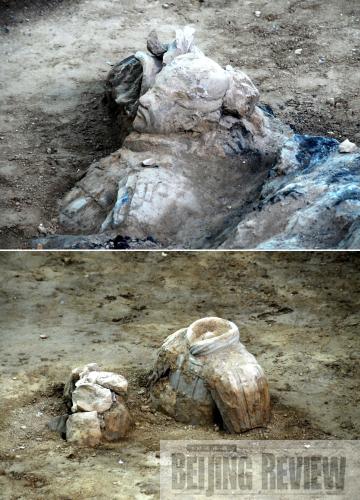|
"Today's technology is now sophisticated enough to preserve the colors of the ancient terracotta," said Zhou Kuiying, an official with the Cultural Heritage Bureau of Shaanxi Province. "Chinese and German researchers have spent 19 years developing preservation techniques, which have been approved for use by the government."
The third excavation of Pit 1 will test preservation technology that the museum has spent decades developing to keep the figures intact and retaining their original colors, said Liu of the museum.
"We will strive to protect the colors on the clay figures, and we believe we are technically able to do this," said archeologist Yuan Zongyi, who has taken part in two previous excavations.
Previously, the ceramic's colored layer would curve and peel off from the body five minutes after it was unearthed and exposed to air.
Chinese archeologists have developed some ways to cope with that problem. First they spray water to make the covering earth loose, and then clear the dirt away with bamboo sticks and a surgeon's knife. They then wash the uncovered part using cotton balls. Next they inject a fixative liquid into the different layers to keep them from falling apart. It can take nine months or longer to fully unearth a colored terracotta warrior.
 |
|
UNDERGROUD TRUTH: A clay figure that was unearthed after a trial excavation in Pit 1 of the Qinshihuang Mausoleum in Xi'an, Shaanxi Province (XINHUA) |
The First Emperor
Emperor Qinshihuang (259 -210 B.C.), whose original name was Ying Zheng, was king of the State of Qin during the Warring States Period (475-221 B.C.). He became the first emperor of a unified China in 221 BC. He ruled until his death at the age of 50.
Emperor Qinshihuang remains a controversial figure in Chinese history. After unifying China, he and his chief adviser, Li Si, passed a series of major economic and political reforms. He undertook gigantic projects, including the first version of the Great Wall of China, the now famous city-sized mausoleum guarded by a life-sized terracotta army and a massive national road system, all at the expense of many lives. To ensure stability of his rule, he outlawed and burned many books. Despite the tyranny of his autocratic rule, he is regarded as a pivotal figure in the nation's history.
| 